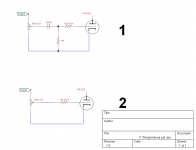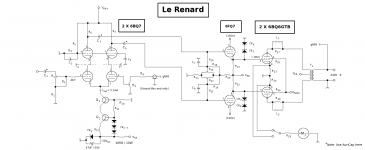If it's a grid leak resistor, it needs to be 1meg or higher. Circuit 1 is best.
If you have a cathode resistor which lifts the cathode above ground, the 50k pot will provide the necessary grid connection to ground. Even so, it's a good idea to install a resistor from the grid to ground for protection in the event that the pot fails.
If you have a cathode resistor which lifts the cathode above ground, the 50k pot will provide the necessary grid connection to ground. Even so, it's a good idea to install a resistor from the grid to ground for protection in the event that the pot fails.
Simple SE schematic
visual of what frank is talking about.
If you need a cap it should be after the pot if the source is already cap coupled. If the source doesnt have an output cap then you want it before the pot.
visual of what frank is talking about.
If you need a cap it should be after the pot if the source is already cap coupled. If the source doesnt have an output cap then you want it before the pot.
If it's a grid leak resistor, it needs to be 1meg or higher. Circuit 1 is best.
If you have a cathode resistor which lifts the cathode above ground, the 50k pot will provide the necessary grid connection to ground. Even so, it's a good idea to install a resistor from the grid to ground for protection in the event that the pot fails.
So if I have 12AX7 triode stage with say 100k plate resistor and 1k cathode resistor, the value of grid leak resistor is not important and will not effect the performance right?
I didn´t make myself clear. I do not have any DC on input pot. But for the tube is it better that tube have 1M grid leak resistor or it can be small from 0k to 50k and it will not effect tube performance?
Yes there is DC current in #2. In #2 the grid leak current goes to ground through the pot. DC current flows through the wiper and then the lower leg of the pot. So you will hear so "static" on the volume control
But the coupling cap introduces some tiny distortion and you'd prefer not to have it. In that case change the pot to a stepped attenuation switch. These stepped switches are electrically just like a pot but don't have the static problem.
Or maybe you never intend to use the volume control on a power amp. It's something you adjust one and leave alone for weeks at a time, so crackle and static are not issues. then #1 would be OK.
Guitar amps solve this problem nicely by using option #3 "none of the above" and placing the "volume" control after the first tiode gain stage. (The reason is that these amps need to have a 1M or higher input impedance and you can't get that using a volume pot on the input jack) It turns out you need a coupling cap between stages so it does double duty to also keep DC off the pot, so no added cap. But for HiFi where to have a good line level source just go with #2.
None of the above. I do this: (attached). Use a 100K linear pot, and parallel it with a 16K8 resistor. That not only gives you a log taper function, it also provides a guard resistor that will keep the grid connected to DC ground should the pot fail open. Linear pots aren't as liable to go scrathcy as log taper pots.
If you are absolutely sure you will never connect to anything that has a DC offset, you might be able to remove the coupling capacitor.
(In this case, R2 is a 56R resistor to keep the pot from "bottoming out" to prevent those annoying speaker pops when the pot hits bottom. You may or may not want to include it.)
If you are absolutely sure you will never connect to anything that has a DC offset, you might be able to remove the coupling capacitor.
(In this case, R2 is a 56R resistor to keep the pot from "bottoming out" to prevent those annoying speaker pops when the pot hits bottom. You may or may not want to include it.)
Attachments
Last edited:
So if I have 12AX7 triode stage with say 100k plate resistor and 1k cathode resistor, the value of grid leak resistor is not important and will not effect the performance right?
Within a reasonable range you are right. As long a the grid leak resistor is under the mac value you are fine. For the 12AX7 the largest allowed resistor is 2.2M (From JJ's data sheet)
If the resistor is larger than 2.2M the grid becomes "grid leak biased". Where it collects enough charge to effect the bias
Yes you did. Mooly and I answered your question. If you want low noise keep DC away from pots.kacernator said:I didn´t make myself clear.
Yes. Valves have a maximum grid leak specified in the data sheet, but not a minimum. A small grid leak will affect circuit performance, as it will load whatever comes before but it won't harm valve performance.it can be small from 0k to 50k and it will not effect tube performance?
with the talk of DC noise, is this only when the pots are turned?
is there increased noise with a small amount of DC on an input pot if the pot is stationary?
i believe someone replied to this effect but wanted some direct clarity on the issue.
because...hey, putting up with some scratches to get rid of a coupling cap? sign me up.
is there increased noise with a small amount of DC on an input pot if the pot is stationary?
i believe someone replied to this effect but wanted some direct clarity on the issue.
because...hey, putting up with some scratches to get rid of a coupling cap? sign me up.
- Status
- This old topic is closed. If you want to reopen this topic, contact a moderator using the "Report Post" button.
- Home
- Design & Build
- Parts
- Input volume pot wiring

